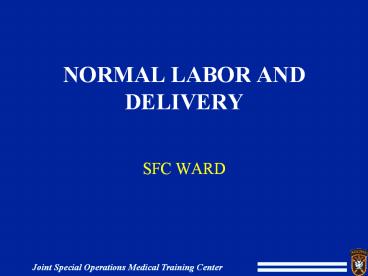NORMAL LABOR AND DELIVERY - PowerPoint PPT Presentation
Title:
NORMAL LABOR AND DELIVERY
Description:
SFC WARD Terminology Gravida - number of pregnancies Para - number of pregnancies carried to viability and delivered Primigravida - pregnant for first time ... – PowerPoint PPT presentation
Number of Views:467
Avg rating:3.0/5.0
Title: NORMAL LABOR AND DELIVERY
1
NORMAL LABOR AND DELIVERY
- SFC WARD
2
Terminology
- Gravida - number of pregnancies
- Para - number of pregnancies carried to viability
and delivered - Primigravida - pregnant for first time
- Multigravida - pregnant more than once
- Viability - able to survive outside the womb (24
weeks gestation) - Nulliparous - never carried a pregnancy to
viability - Multiparous - has had two or more deliveries that
were carried to viability
3
Duration of Pregnancy
- Average 280 days or 40 weeks (9 lunar months)
- Estimated Date of Confinement (EDC)
- Nageles rule
- Date of first day of LMP
- Subtract 3 months
- Add 7 days
- Accurate to plus or minus 2.5 weeks
4
First Stage of Labor
- Begins with onset of coordinated contractions
leading to dilation of cervical os and ends with
complete dilation (10 cm) of the cervical os. - False Labor (Braxton Hicks contractions)
- Cervix fails to dilate greater than 2 cm
- Duration of first stage -
- Primigravida 12 hours
- Multiparous 7 hours or less
5
First Stage of LaborContractions
- Interval
- 10 to 20 minutes between contractions early
labor - 3 to 5 minutes between contractions late labor
- Duration
- 20 second long contraction early labor
- 40 to 80 second long contraction late labor
- Quality
- Uterus can be dented (poor quality) early labor
- Uterus is hard (good quality) late labor
6
First Stage of Labor
- Management
- Take VS between contractions
- Fetal Heart Rate should be between 120 - 160 BPM
- Mother should be coached to relax and conserve
energy between contractions
7
Assessing Progress of Labor
- Vaginal Exam
- Cervix
- Soft or Hard
- Effaced or Thick
- Dilatation
- Presentation
- Part (cephalic, breech, shoulder)
- Flexion, Extension
- Station
8
Second Stage of Labor
- Begins with complete dilation of the cervix and
ends with delivery of fetus - Duration of Second Stage -
- Primigravida 50 minutes
- Multiparous 20 minutes or less
- Contractions
- Interval 2 to 3 minutes
- Duration 50 to 100 seconds
9
Second Stage of Labor
- Management
- Mother may feel urge to push, coach to push only
during a contraction once the cervix has been
determined to be fully dilated - Episiotomy
- Perform to avoid unecessary tearing when head is
crowning - Controlled delivery avoids need for episiotomy in
most cases
10
Second Stage of Labor
- Episiotomy
- Anesthetize with pudendal block
- Put two fingers into the vagina along the
posterior wall - Place one blade of scissors between fingers
inside vagina, other blade outside vagina toward
anus - Cut to approximately 1 inch away from anus during
a contraction
11
(No Transcript)
12
(No Transcript)
13
Second Stage of Labor
- Delivery of head - CONTROL head to prevent
explosive delivery and subsequent tearing - Check for presence of cord around neck
- Aspirate oral and nasal cavities with bulb
syringe - Deliver anterior shoulder with downward pressure
- Complete delivery and HANG ON TO BABY!
14
Second Stage of Labor
- Clear airway, Assess respirations, Resuscitate if
necessary - Clamp cord when pulsations cease
- Leave 3 - 6 inches of cord on baby
- Obtain blood for fetal labs from the placental
stub of cord
15
Third Stage of Labor
- Begins after delivery of baby and ends with
delivery of the placenta - Average duration 8 minutes
- Signs of separation
- Uterus rises to become globular
- Increase (gush) of blood from vagina
- Lengthening of cord
- Do not PULL cord. Apply gentle traction
- Check Placenta for completeness
16
(No Transcript)
17
Third Stage of Labor
- Recover missing pieces of placenta as necessary
- Massage uterus to aid in hemostasis
- IV Oxytocin can be given if available to aid
uterine contractions and aid in hemostasis
18
Neonatal Care
- Reassess Airway and Respirations
- Keep warm and dry
- Eye drops (1 silver nitrate or Neosporin)
- Allow for maternal bonding
- Stimulation of nipples during attempts at
breastfeeding will aid in release of oxytocin by
posterior pituitary gland resulting in uterine
contraction and hemorrhage control
19
APGAR
- Taken at 1 minute and 5 minutes after delivery
- Score of zero to two is given for each category
- The higher the score, the more vigorous and
healthy the child is considered to be
20
APGAR
- APPEARANCE
- 2 Completely Pink
- 1 Hands and Feet are blue
- 0 Paleness and blue color over entire body
- PULSE (most important sign)
- 2 Greater than 100 BPM
- 1 Detectable rate below 100 BPM
- 0 No heart rate detected
21
APGAR
- GRIMACE (flexing and muscle tone of limbs and
resistance to straightening) - 2 Normal muscle tone
- 1 Limp to normal muscle tone
- 0 No resistance to straightening
- ACTIVITY (response to flicking of foot)
- 2 Infant cries in response to flick
- 1 Weak cry or head movement in response
- 0 No response
22
APGAR
- RESPIRATORY (Second most important)
- 2 Regular respirations and vigorous cry
- 1 Weak cry
- 0 No respiratory response
- Scoring
- 7 to 10 provide supportive care
- 4 to 6 indicates moderate depression
- lt 4 requires aggressive resuscitation
23
(No Transcript)
24
(No Transcript)
25
Emergency Birth Video
26
SUMMARY
- First Stage of Labor
- Second Stage of Labor
- Third Stage of Labor
- APGAR
27
?































